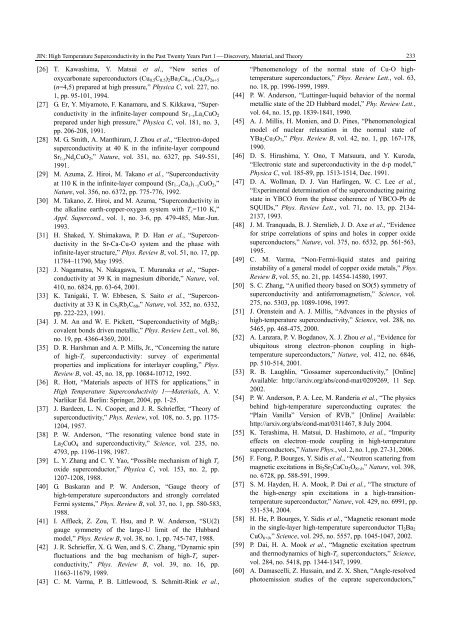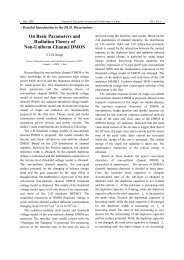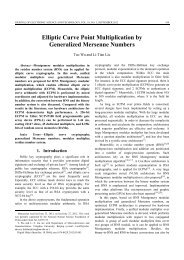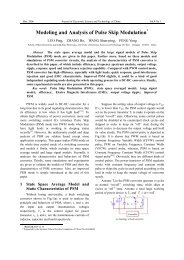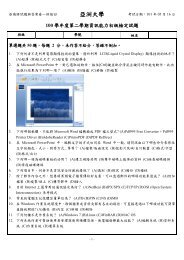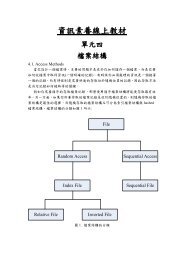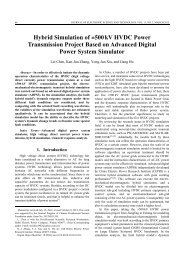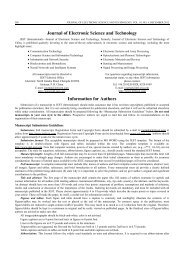High Temperature Superconductivity in the Past Twenty Years Part 1 ...
High Temperature Superconductivity in the Past Twenty Years Part 1 ...
High Temperature Superconductivity in the Past Twenty Years Part 1 ...
You also want an ePaper? Increase the reach of your titles
YUMPU automatically turns print PDFs into web optimized ePapers that Google loves.
JIN: <strong>High</strong> <strong>Temperature</strong> <strong>Superconductivity</strong> <strong>in</strong> <strong>the</strong> <strong>Past</strong> <strong>Twenty</strong> <strong>Years</strong> <strong>Part</strong> 1 ⎯ Discovery, Material, and Theory 233[26] T. Kawashima, Y. Matsui et al., “New series ofoxycarbonate superconductors (Cu 0.5 C 0.5 ) 2 Ba 3 Ca n−1 Cu n O 2n+5(n=4,5) prepared at high pressure,” Physica C, vol. 227, no.1, pp. 95-101, 1994.[27] G. Er, Y. Miyamoto, F. Kanamaru, and S. Kikkawa, “<strong>Superconductivity</strong><strong>in</strong> <strong>the</strong> <strong>in</strong>f<strong>in</strong>ite-layer compound Sr 1−x La x CuO 2prepared under high pressure,” Physica C, vol. 181, no. 3,pp. 206-208, 1991.[28] M. G. Smith, A. Manthiram, J. Zhou et al., “Electron-dopedsuperconductivity at 40 K <strong>in</strong> <strong>the</strong> <strong>in</strong>f<strong>in</strong>ite-layer compoundSr 1-y Nd y CuO 2 ,” Nature, vol. 351, no. 6327, pp. 549-551,1991.[29] M. Azuma, Z. Hiroi, M. Takano et al., “<strong>Superconductivity</strong>at 110 K <strong>in</strong> <strong>the</strong> <strong>in</strong>f<strong>in</strong>ite-layer compound (Sr 1−x Ca x ) 1−y CuO 2 ,”Nature, vol. 356, no. 6372, pp. 775-776, 1992.[30] M. Takano, Z. Hiroi, and M. Azuma, “<strong>Superconductivity</strong> <strong>in</strong><strong>the</strong> alkal<strong>in</strong>e earth-copper-oxygen system with T c =110 K,”Appl. Supercond., vol. 1, no. 3-6, pp. 479-485, Mar.-Jun.1993.[31] H. Shaked, Y. Shimakawa, P. D. Han et al., “<strong>Superconductivity</strong><strong>in</strong> <strong>the</strong> Sr-Ca-Cu-O system and <strong>the</strong> phase with<strong>in</strong>f<strong>in</strong>ite-layer structure,” Phys. Review B, vol. 51, no. 17, pp.11784–11790, May 1995.[32] J. Nagamatsu, N. Nakagawa, T. Muranaka et al., “<strong>Superconductivity</strong>at 39 K <strong>in</strong> magnesium diboride,” Nature, vol.410, no. 6824, pp. 63-64, 2001.[33] K. Tanigaki, T. W. Ebbesen, S. Saito et al., “<strong>Superconductivity</strong>at 33 K <strong>in</strong> Cs x Rb y C 60 ,” Nature, vol. 352, no. 6332,pp. 222-223, 1991.[34] J. M. An and W. E. Pickett, “<strong>Superconductivity</strong> of MgB 2 :covalent bonds driven metallic,” Phys. Review Lett., vol. 86,no. 19, pp. 4366-4369, 2001.[35] D. R. Harshman and A. P. Mills, Jr., “Concern<strong>in</strong>g <strong>the</strong> natureof high-T c superconductivity: survey of experimentalproperties and implications for <strong>in</strong>terlayer coupl<strong>in</strong>g,” Phys.Review B, vol. 45, no. 18, pp. 10684-10712, 1992.[36] R. Hott, “Materials aspects of HTS for applications,” <strong>in</strong><strong>High</strong> <strong>Temperature</strong> <strong>Superconductivity</strong> 1⎯Materials, A. V.Narlikar Ed. Berl<strong>in</strong>: Spr<strong>in</strong>ger, 2004, pp. 1-25.[37] J. Bardeen, L. N. Cooper, and J. R. Schrieffer, “Theory ofsuperconductivity,” Phys. Review, vol. 108, no. 5, pp. 1175-1204, 1957.[38] P. W. Anderson, “The resonat<strong>in</strong>g valence bond state <strong>in</strong>La 2 CuO 4 and superconductivity,” Science, vol. 235, no.4793, pp. 1196-1198, 1987.[39] L. Y. Zhang and C. Y. Yao, “Possible mechanism of high T coxide superconductor,” Physica C, vol. 153, no. 2, pp.1207-1208, 1988.[40] G. Baskaran and P. W. Anderson, “Gauge <strong>the</strong>ory ofhigh-temperature superconductors and strongly correlatedFermi systems,” Phys. Review B, vol. 37, no. 1, pp. 580-583,1988.[41] I. Affleck, Z. Zou, T. Hsu, and P. W. Anderson, “SU(2)gauge symmetry of <strong>the</strong> large-U limit of <strong>the</strong> Hubbardmodel,” Phys. Review B, vol. 38, no. 1, pp. 745-747, 1988.[42] J. R. Schrieffer, X. G. Wen, and S. C. Zhang, “Dynamic sp<strong>in</strong>fluctuations and <strong>the</strong> bag mechanism of high-T c superconductivity,”Phys. Review B, vol. 39, no. 16, pp.11663-11679, 1989.[43] C. M. Varma, P. B. Littlewood, S. Schmitt-R<strong>in</strong>k et al.,“Phenomenology of <strong>the</strong> normal state of Cu-O hightemperaturesuperconductors,” Phys. Review Lett., vol. 63,no. 18, pp. 1996-1999, 1989.[44] P. W. Anderson, “Lutt<strong>in</strong>ger-luquid behavior of <strong>the</strong> normalmetallic state of <strong>the</strong> 2D Hubbard model,” Phy. Review Lett.,vol. 64, no. 15, pp. 1839-1841, 1990.[45] A. J. Millis, H. Monien, and D. P<strong>in</strong>es, “Phenomenologicalmodel of nuclear relaxation <strong>in</strong> <strong>the</strong> normal state ofYBa 2 Cu 3 O 7 ,” Phys. Review B, vol. 42, no. 1, pp. 167-178,1990.[46] D. S. Hirashima, Y. Ono, T Matsuura, and Y. Kuroda,“Electronic state and superconductivity <strong>in</strong> <strong>the</strong> d-p model,”Physica C, vol. 185-89, pp. 1513-1514, Dec. 1991.[47] D. A. Wollman, D. J. Van Harl<strong>in</strong>gen, W. C. Lee et al.,“Experimental determ<strong>in</strong>ation of <strong>the</strong> superconduct<strong>in</strong>g pair<strong>in</strong>gstate <strong>in</strong> YBCO from <strong>the</strong> phase coherence of YBCO-Pb dcSQUIDs,” Phys. Review Lett., vol. 71, no. 13, pp. 2134-2137, 1993.[48] J. M. Tranquada, B. J. Sternlieb, J. D. Axe et al., “Evidencefor stripe correlations of sp<strong>in</strong>s and holes <strong>in</strong> copper oxidesuperconductors,” Nature, vol. 375, no. 6532, pp. 561-563,1995.[49] C. M. Varma, “Non-Fermi-liquid states and pair<strong>in</strong>g<strong>in</strong>stability of a general model of copper oxide metals,” Phys.Review B, vol. 55, no. 21, pp. 14554-14580, 1997.[50] S. C. Zhang, “A unified <strong>the</strong>ory based on SO(5) symmetry ofsuperconductivity and antiferromagnetism,” Science, vol.275, no. 5303, pp. 1089-1096, 1997.[51] J. Orenste<strong>in</strong> and A. J. Millis, “Advances <strong>in</strong> <strong>the</strong> physics ofhigh-temperature superconductivity,” Science, vol. 288, no.5465, pp. 468-475, 2000.[52] A. Lanzara, P. V. Bogdanov, X. J. Zhou et al., “Evidence forubiquitous strong electron–phonon coupl<strong>in</strong>g <strong>in</strong> hightemperaturesuperconductors,” Nature, vol. 412, no. 6846,pp. 510-514, 2001.[53] R. B. Laughl<strong>in</strong>, “Gossamer superconductivity,” [Onl<strong>in</strong>e]Available: http://arxiv.org/abs/cond-mat/0209269, 11 Sep.2002.[54] P. W. Anderson, P. A. Lee, M. Randeria et al., “The physicsbeh<strong>in</strong>d high-temperature superconduct<strong>in</strong>g cuprates: <strong>the</strong>“Pla<strong>in</strong> Vanilla” Version of RVB,” [Onl<strong>in</strong>e] Available:http://arxiv.org/abs/cond-mat/0311467, 8 July 2004.[55] K. Terashima, H. Matsui, D. Hashimoto, et al., “Impurityeffects on electron–mode coupl<strong>in</strong>g <strong>in</strong> high-temperaturesuperconductors,” Nature Phys., vol. 2, no. 1, pp. 27-31, 2006.[56] F. Fong, P. Bourges, Y. Sidis et al., “Neutron scatter<strong>in</strong>g frommagnetic excitations <strong>in</strong> Bi 2 Sr 2 CaCu 2 O 8+δ ,” Nature, vol. 398,no. 6728, pp. 588-591, 1999.[57] S. M. Hayden, H. A. Mook, P. Dai et al., “The structure of<strong>the</strong> high-energy sp<strong>in</strong> excitations <strong>in</strong> a high-transitiontemperaturesuperconductor,” Nature, vol. 429, no. 6991, pp.531-534, 2004.[58] H. He, P. Bourges, Y. Sidis et al., “Magnetic resonant mode<strong>in</strong> <strong>the</strong> s<strong>in</strong>gle-layer high-temperature superconductor Tl 2 Ba 2CuO 6+δ ,” Science, vol. 295, no. 5557, pp. 1045-1047, 2002.[59] P. Dai, H. A. Mook et al., “Magnetic excitation spectrumand <strong>the</strong>rmodynamics of high-T c superconductors,” Science,vol. 284, no. 5418, pp. 1344-1347, 1999.[60] A. Damascelli, Z. Hussa<strong>in</strong>, and Z. X. Shen, “Angle-resolvedphotoemission studies of <strong>the</strong> cuprate superconductors,”


